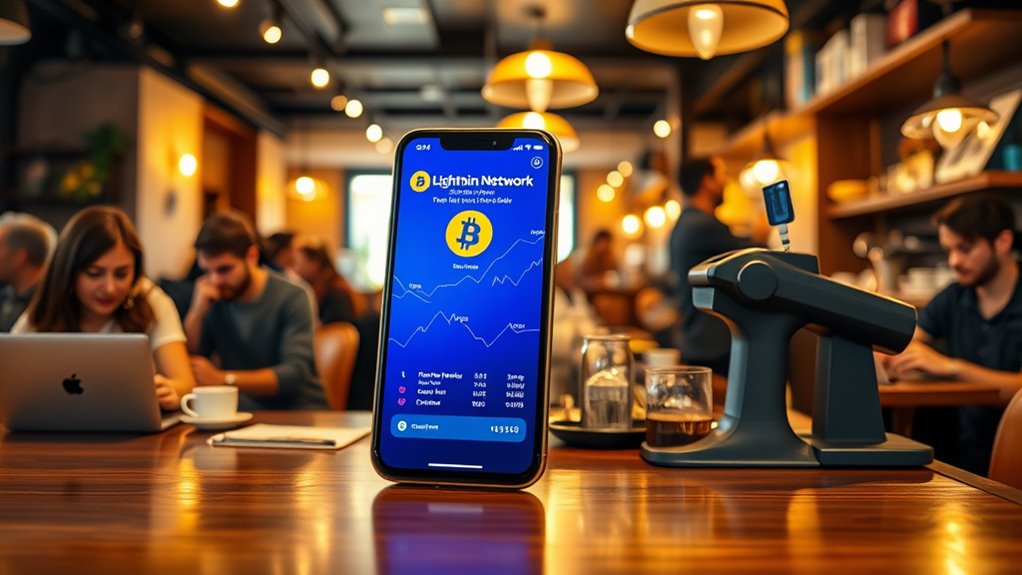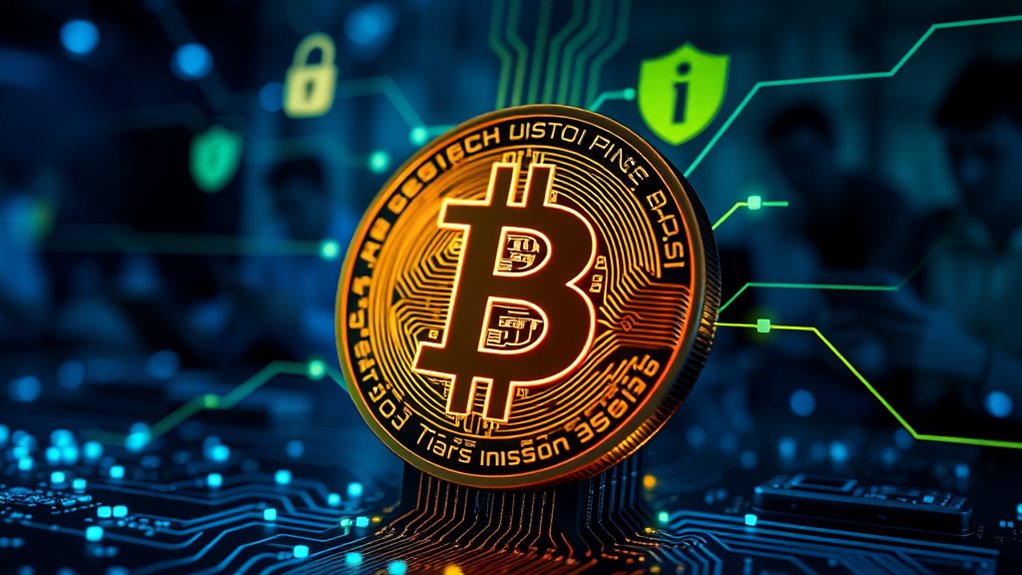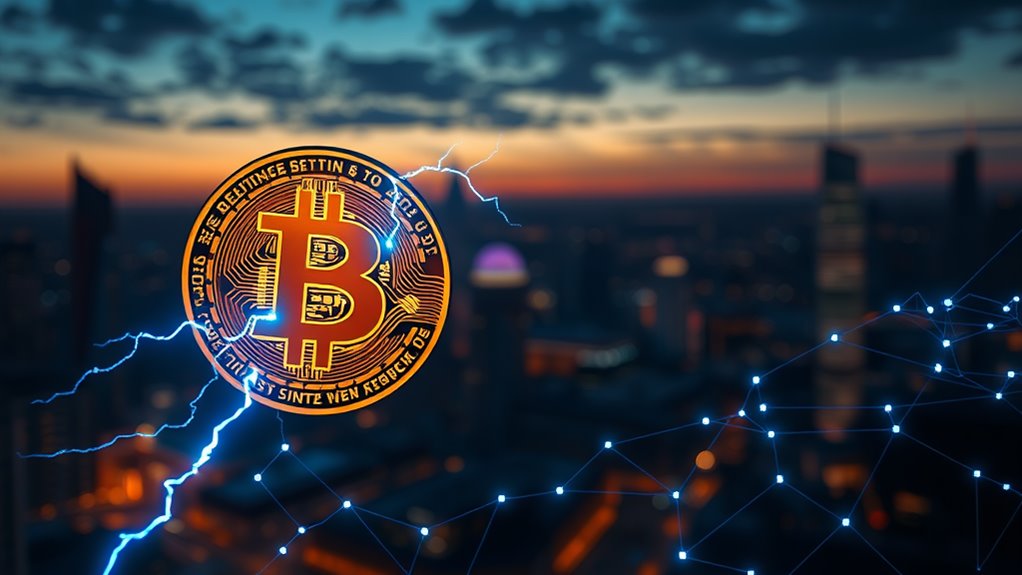
Bitcoin Lightning Network: Unlocking Fast & Secure Transactions
The Bitcoin Lightning Network operates as a second-layer protocol that addresses Bitcoin's scalability limitations by enabling near-instant transactions with minimal fees. This off-chain solution creates payment channels between users, allowing multiple transactions without recording each one on the main blockchain. Using Hash Time-Locked Contracts (HTLCs), the Lightning Network maintains security while processing millions of transactions per second compared to Bitcoin's seven. The technology transforms Bitcoin from primarily a store of value into a practical medium for everyday purchases and micropayments.
Key Takeaways
- The Lightning Network enables near-instant Bitcoin transactions by operating off-chain, processing millions per second compared to Bitcoin's 7 transactions per second.
- Payment channels allow multiple transactions between parties without recording each on the blockchain, significantly reducing fees and congestion.
- Hash Time-Locked Contracts (HTLCs) ensure secure, trustless transactions across multiple network participants without requiring immediate blockchain confirmation.
- Adoption has grown substantially, with Lightning Network processing 16.6% of all Bitcoin payments by Q2 2024 and integration by major platforms.
- Multi-signature security and Watchtowers protect funds in payment channels, though users must manage liquidity and monitor channel states.
How the Lightning Network Revolutionizes Bitcoin Transactions

While traditional Bitcoin transactions often face challenges with speed and scalability, the Lightning Network emerges as a groundbreaking solution that addresses these limitations.
By operating off-chain, the network enables transactions to complete in seconds rather than minutes or hours required for on-chain settlements.
This second-layer protocol creates payment channels between users that allow multiple transactions to occur without immediately recording each one on the blockchain. Only when channels close are the final balances settled on-chain.
This approach dramatically reduces congestion on the main Bitcoin network while enabling near-instant payments.
The Lightning Network's sophisticated routing system finds ideal paths between nodes, making Bitcoin viable for everyday purchases and even micropayments that were previously impractical due to fees and confirmation times.
The Technical Architecture Behind Lightning Payment Channels

Lightning Network payment channels utilize sophisticated state management to track the balance between parties as transactions occur.
Each new transaction creates a new channel state, which is signed by both parties and includes the updated balances without requiring on-chain recording.
Hash Time-Locked Contracts (HTLCs) serve as the security backbone of these channels, enabling conditional payments that can either complete successfully or automatically return to the sender after a specified timeframe.
Channel State Management
At the heart of the Lightning Network's architecture lies a sophisticated system of channel state management that facilitates the seamless flow of Bitcoin transactions off-chain. This system relies on balance sheets maintained by both parties in a payment channel, reflecting all transactions without requiring immediate blockchain recording.
When users conduct transactions through Lightning channels, their balances update instantaneously while maintaining privacy. These off-chain transactions allow for near-instant settlement without waiting for blockchain confirmations. The current state of each channel represents an agreement between participants about fund distribution.
If disputes arise or when channels need closing, the final balances are broadcast to the Bitcoin blockchain. This process, supported by multisignature security, guarantees that funds can only move with both parties' consent, maintaining the integrity of the Lightning Network while leveraging Bitcoin's underlying security.
Hash Time-Locked Contracts
Hash Time-Locked Contracts (HTLCs) form the backbone of the Lightning Network's revolutionary payment system, enabling secure and trustless transactions without requiring immediate blockchain confirmation.
These smart contracts combine hash locks and time locks to guarantee funds either reach their intended recipient or return to the sender after a specified timeframe.
HTLCs facilitate multi-hop payments across the Lightning Network through a series of conditional transactions where each node creates an HTLC, with payment success dependent on preimage revelation.
This technical architecture offers several key advantages:
- Atomic transactions that cannot be partially fulfilled
- Nearly instant settlement through off-chain processing
- Significant reduction in transaction fees compared to on-chain payments
- Support for cross-chain transactions through similar mechanisms like atomic swaps
Setting Up Your First Lightning Wallet: A Step-by-Step Guide

Setting up a Lightning Network wallet involves selecting the appropriate type based on security preferences and technical comfort level, with options ranging from beginner-friendly custodial wallets to more secure non-custodial alternatives.
After installation from official sources, users must fund their wallet with Bitcoin to establish payment channels, which serve as the foundation for Lightning transactions.
The final step involves initiating a small test transaction to verify proper configuration, allowing users to experience the network's benefits of fast settlement times and minimal fees.
Choose the Right Wallet
Selecting the appropriate Lightning wallet represents an essential first step in your journey with Bitcoin's Lightning Network.
Users must determine whether a custodial or non-custodial solution better aligns with their needs based on technical comfort, security preferences, and intended use.
Popular options include:
- Wallet of Satoshi – A beginner-friendly custodial wallet with simple interface
- Phoenix Wallet – Non-custodial option with instant payments for iOS and Android
- Blue Wallet – User-friendly wallet supporting multiple platforms
- Muun Wallet – Supports submarine swaps with iOS and Android compatibility
When choosing, consider factors like ease of use, security features, compatibility with your devices, and integration with services you plan to use.
Beginners might prefer custodial options for simplicity, while those prioritizing security may opt for non-custodial wallets despite the additional technical requirements.
Unlike traditional Bitcoin wallets, Lightning wallets typically offer faster transactions while still allowing users to implement cold storage solutions for enhanced security by keeping most funds offline.
Funding Payment Channels
Once a suitable wallet has been selected, users must establish payment channels, the foundational elements that enable the Lightning Network's functionality.
Opening a channel requires setting up a multi-signature wallet and committing an initial amount of Bitcoin, which is recorded on the blockchain.
Payment channels greatly reduce transaction fees by moving payments off-chain, allowing for nearly instant settlements. Users need to connect to Lightning Network nodes and balance liquidity within their channels for ideal performance.
While opening and closing channels incurs on-chain transaction costs, frequent usage offsets these expenses.
Effective channel management involves maintaining sufficient funds for transactions and understanding the technical requirements.
Unlike traditional hot wallets, Lightning Network wallets combine online accessibility with enhanced transaction speed while maintaining key security protocols.
Despite challenges like the need for users to be online and manage channel liquidity, the Lightning Network's ability to facilitate micropayments and fast transactions makes it a valuable solution for Bitcoin's scalability issues.
First Transaction Walkthrough
Maneuvering the Lightning Network begins with choosing an appropriate wallet that meets individual needs and technical comfort levels. Users can select between custodial options like Wallet of Satoshi for simplicity or non-custodial alternatives such as Breez or Blue Wallet for greater control over funds.
Once installed, the wallet setup typically involves creating or importing a seed phrase for backup purposes.
- Send a small test transaction first to gain familiarity with the system
- Look for QR code scanning functionality to simplify payment addressing
- Check the routing fee before confirming transactions
- Monitor channel liquidity to guarantee sufficient funds for future transactions
Most Lightning wallets automate the complex routing process, allowing users to focus simply on the recipient and amount. Transactions typically confirm within seconds, demonstrating the network's efficiency compared to traditional Bitcoin transactions.
Lightning Network vs. On-Chain Bitcoin Transactions: Key Differences

When comparing Bitcoin's transaction methods, fundamental differences emerge between traditional on-chain transactions and the Lightning Network.
On-chain transactions offer maximum security but process slowly at about 7 transactions per second, with confirmation times averaging 10 minutes per block. During network congestion, these transactions become both slower and more expensive.
The Lightning Network, by contrast, processes transactions almost instantly through payment channels that operate off the main blockchain. This system can handle millions of transactions per second with minimal fees, making it ideal for microtransactions and frequent payments.
While the Lightning Network relies on the underlying Bitcoin blockchain for security during channel settlements, it dramatically improves Bitcoin's scalability without sacrificing its decentralized nature. This efficiency comes through smart contracts that securely manage payment channels.
Real-World Applications and Use Cases for Lightning Payments

The Lightning Network has transformed Bitcoin from a primarily store-of-value asset into a practical medium for everyday transactions across numerous sectors.
This second-layer solution enables micropayments with near-instant confirmation and minimal fees, making it ideal for a range of applications:
- E-commerce Integration – Platforms like Shopify now support Lightning payments, allowing merchants to receive instant settlements without the risks of traditional payment processing.
- Social Media Tipping – Twitter and content platforms leverage Lightning for seamless microtransactions, empowering creators.
- Cross-Border Remittances – Services like Strike dramatically reduce costs and processing times for international money transfers.
- Machine-to-Machine Payments – Emerging applications enable IoT devices to conduct autonomous microtransactions, particularly in energy markets.
Security Considerations When Using the Lightning Network

Security challenges inherent to the Lightning Network require users to understand potential vulnerabilities while implementing appropriate safeguards. Hot wallets, necessary for Lightning's instant transactions, expose funds to potential hacks, while payment channels face risks from outdated state broadcasts and sophisticated attacks.
| Threat Type | Recommended Mitigation |
|---|---|
| Hot Wallet Vulnerability | Multi-signature security, limit exposure |
| Channel Breaches | Implement Watchtowers for monitoring |
| Replacement Cycling | Keep node software updated |
| Liquidity Constraints | Practice effective channel management |
Protection strategies include regular channel monitoring, implementation of Watchtowers, and utilizing PTLCs with Taproot to enhance privacy. While the Lightning Network considerably improves Bitcoin's transaction capacity, users must remain vigilant against emerging threats like Zombie and Eclipse attacks through proper education and adherence to security protocols.
Current Adoption Status and Major Platform Integrations

Beyond security considerations, Lightning Network adoption has gained remarkable momentum in recent years, reshaping how Bitcoin functions as a payment system. The percentage of Bitcoin payments processed through Lightning has more than doubled from 6.5% in Q2 2022 to 16.6% in Q2 2024, demonstrating its growing significance in the ecosystem.
- Cash App's integration exposed Lightning Network to millions of users, dramatically expanding its potential reach.
- Major exchanges like Coinbase and Kraken have incorporated Lightning support, enhancing accessibility.
- Mercari in Japan has successfully implemented Lightning payments, showcasing real-world merchant adoption.
- El Salvador's Chivo Wallet utilizes Lightning for cross-border transactions, highlighting its international potential.
This organic growth positions Lightning Network as a key enabler in Bitcoin's evolution toward becoming a viable medium for everyday exchanges.
Overcoming Common Lightning Network Challenges

Despite impressive growth in adoption, Lightning Network faces several significant challenges that must be overcome for Bitcoin to reach its full potential as a mainstream payment system.
The network struggles with scalability limitations, as Bitcoin's ten-minute block time restricts transaction throughput, leading to congestion and higher fees during peak periods.
Liquidity issues present another obstacle, with uneven distribution across the network's approximately 5,311.8 BTC total channel capacity.
Security concerns include risks of fraudulent channel closures when nodes go offline, requiring constant monitoring or "watchtower" implementations to prevent theft.
Technical complexity remains a barrier to widespread adoption, as managing payment channels demands specialized knowledge.
Ongoing innovations like multi-path payments, Wumbo channels, and more user-friendly interfaces are gradually addressing these challenges while maintaining the network's core security benefits.
Thoughtful regulatory frameworks could further legitimize Lightning Network by establishing standards that protect users while allowing the innovation needed to overcome these technical hurdles.
The Role of Lightning in Bitcoin's Long-Term Scalability Vision

As Bitcoin continues its journey toward global adoption, the Lightning Network stands as the cornerstone of its long-term scalability strategy.
By enabling off-chain transactions, Lightning addresses Bitcoin's fundamental throughput limitations while preserving its decentralized nature.
Lightning Network's off-chain architecture elegantly solves Bitcoin's scaling challenge while maintaining its decentralized essence.
Lightning's contribution to Bitcoin's future includes:
- Enabling millions of transactions per second versus Bitcoin's 7 TPS
- Making microtransactions economically viable for streaming services and small payments
- Maintaining Bitcoin's decentralized structure while improving efficiency
- Serving as the foundation for Bitcoin to function as a global payment system
This second-layer solution represents a critical evolution that transforms Bitcoin from primarily a store of value into a practical medium for everyday transactions without compromising its core principles.
Unlike alternatives such as Litecoin or Nano that offer faster base layer speeds, the Lightning Network aims to solve Bitcoin's payment limitations while leveraging its unmatched security features and network effects.
Frequently Asked Questions
Can Lightning Network Transactions Be Reversed or Refunded?
Lightning Network transactions cannot be reversed or refunded traditionally. Unlike conventional payment systems, they lack central authorities for chargebacks. Transactions are final once completed, secured by smart contracts and penalty mechanisms for attempted fraud.
How Does Channel Liquidity Affect My Payment Capabilities?
Channel capacity critically constrains payment capabilities. Insufficient inbound liquidity limits receiving funds, while inadequate outbound liquidity prevents sending. Balanced channels enable efficient transactions, while imbalanced ones cause payment failures and routing difficulties.
What Happens to My Funds if My Node Goes Offline?
If a node goes offline, funds remain secure through pre-signed transactions. However, the user cannot send or receive payments until reconnection. Watchtowers can protect against fraudulent channel closures during downtime.
Are Lightning Transactions Truly Anonymous Compared to On-Chain Transactions?
Like shadows in partial light, Lightning transactions offer improved privacy over on-chain transactions, but aren't truly anonymous. They reduce blockchain visibility while remaining vulnerable to sophisticated analysis through routing patterns and network surveillance.
How Do Routing Fees Compare During Network Congestion Periods?
Routing fees on Lightning Network remain relatively stable during congestion periods while on-chain Bitcoin fees increase considerably. Node operators may slightly adjust fees to remain competitive, but Lightning transactions maintain cost efficiency compared to on-chain alternatives.
Conclusion
The Lightning Network represents an essential evolution in Bitcoin's functionality, enabling faster, cheaper transactions while preserving security. Its growing integration with platforms like Cash App and Strike demonstrates real-world viability. As developer El Gato Bitcoin recently showcased, even complex payment routing across 30+ nodes completes in under three seconds. While challenges remain, Lightning's continued development stands as a critical component of Bitcoin's path toward mainstream payment adoption.












